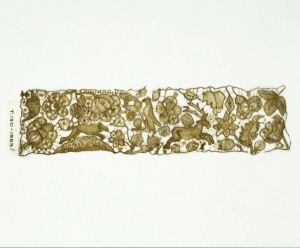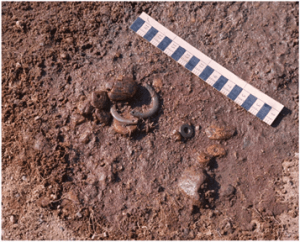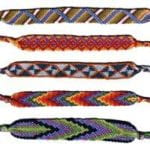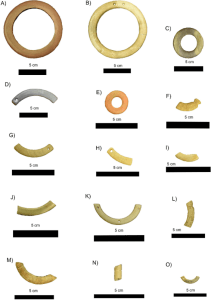Welcome back students, the new semester and school year has begun. You’ve reconnected with friends here at Indiana University of Pennsylvania, but also some of you might have said goodbye to friends in your hometown. Friends play powerful roles in our lives, and sometimes, we wish to show that bond by giving and wearing tokens of our friendship for the world to see. As children, some of us might have even purchased beads and string to create friendship bracelets! These tiny and simple circlets showcased to whomever saw them that those wearing the matching ones were connected, firm, friends.
The origin of friendship bracelets is difficult to track down. Some credit influence to ancient China as decorative knots on bracelets trace back to 481-221 B.C., but these knots were used not solely on bracelets. Macrame is also seen as an influence and was popular in 13th century Arabia, spreading to France and Italy, and was also used by sailors at sea. It became popular in 19th-century Britain and found its way to the United States in the 1960s.

Band of lace made from human (head) hair, likely worn as a bracelet, ca. 1640-1680, in the collection of the V&A.
In the Victorian era, giving mourning jewelry with strands of a loved one’s hair incorporated into the piece was common, and leads some to believe that this also contributes to the trend of exchanging meaningful pieces of jewelry between friends. Others claim that the popular trend youngsters across world take part in today actually dates to ancient Central American times. Many friendships bracelet designs we see today mirror Native American patterns, as well. In the United States, the art of making friendship bracelets became popularized again in the 1980s when they were seen during rallies and protests about the disappearances of Mayan Indians and laborers in Guatemala.
Earlier this year though, archaeologists in modern-day Finland made an incredible discovery. They found both intact and fragmented ‘slate rings’ that date back to around the 4th millennium B.C. at several Stone Age sites. The ring-shaped artifacts were made of different slates and tuffites. After studying geochemical composition, micro details, and use-wear, and piecing fragments back together, it was suggested that many of the rings were actually broken up on purpose and as part of the prominent gift-giving system in that region. Many of the fragments appear to have been fashioned into pendants and some from the same ring were even found in two different locations with different finishes, thus showing that the fragments were used as ‘friendship ornaments’ or “tokens of social relationships.” The few that were intact, were “likely worn as personal ornaments.”

Ringed ornaments in situ in an early 4th millennium BC hunter-gatherer burial, positioned together with amber pendants. Photo. M. Torvinen 1978/Finnish Heritage Agency
Some of the slate traces back to a region in northwest Russia near Lake Onega, supporting theories of widespread trade networks in northeastern Europe and social relationships with people hundreds of kilometers away. Some fragments were also found at settlement sites, with the matching fragment from the same ring, stone, and manufacturing process being found at a nearby burial site. This practice suggests there was a belief in a connection between the living and the dead through the use of these objects prevalent during this time period in this region.
It’s fascinating to think that by wearing a broken heart trinket around your neck or tying a woven or beaded string around your wrist, you have something in common with the person that around 5,000 years ago wore a whole or fragmented slate circle to also represent their social bonds and relationships with others.
Follow IUP Anthropology on Facebook, Twitter, and Instagram
Sources and Further Reading
https://link.springer.com/article/10.1007/s10816-022-09556-8
https://ancient-archeology.com/these-5000-year-old-stone-age-rings-may-have-been-the-original-friendship-bracelets/
https://www.keyssoulcare.com/connection/the-history-of-friendship-bracelets.html#:~:text=The%20exact%20origin%20of%20the%20friendship%20bracelet%20is,recognizes%20the%20Native%20American%20tradition%20of%20exchanging%20bracelets.
https://www.braceletbook.com/history/#:~:text=A%20friendship%20bracelet%20is%20a%20handmade%20bracelet%20intended%20for%20a%20special%20person.&text=Macrame%2C%20a%20craft%20of%20tying,items%20made%20on%20a%20loom.
https://www.wristband.com/content/all_about_friendship_bracelets/
https://www.jewelslane.com/blog/the-origin-meaning-and-importance-of-friendship-bracelets
https://www.novica.com/blog/friendship-bracelets-their-origin-meaning-and-importance/
https://www.harbourukbracelets.com/blog/friendship-bracelets-their-history-and-significance-explained
https://ericaweiner.com/history-lessons/hair%20jewelry

